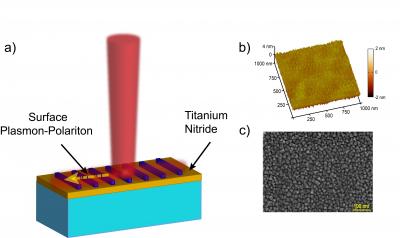Researchers from the Purdue University have used a thin film of titanium nitride as a plasmonic material. The addition of titanium nitride to the small list of surface-plasmon-supporting materials may pave the way to produce new optoelectronic devices with unparallel efficiency and speed.
 This image shows a) Excitation by light of a surface plasmon-polariton on a thin film of titanium nitride. b) Atomic force microscope image of the surface of titanium nitride film. The mean roughness of the film is 0.5 nm. c) Scanning electron microscopy image of TiN thin film on sapphire. The texture shows multivariant epitaxial (crystalline) growth. Credit: Alexandra Boltasseva, Purdue University/Optical Materials Express.
This image shows a) Excitation by light of a surface plasmon-polariton on a thin film of titanium nitride. b) Atomic force microscope image of the surface of titanium nitride film. The mean roughness of the film is 0.5 nm. c) Scanning electron microscopy image of TiN thin film on sapphire. The texture shows multivariant epitaxial (crystalline) growth. Credit: Alexandra Boltasseva, Purdue University/Optical Materials Express.
Metals carry only electricity and do not transmit light waves. Surface plasmons, which are light-coupled oscillations formed on the metal surfaces, are exceptional in this regard. When plasmons are excited by light waves at a particular frequency, it is retained as such. However, at smaller wavelengths, they produce near-infrared or crammed visible light into the nanoscale realm.
Silver and gold were considered to be good plasmonic materials, but they were incompatible to normal silicon producing technologies, which limited their use for viable products. Silver better act as surface plasmon with optical characteristics; however, it produces semi-continuous or grainy thin films and it also degrades in air, which results in optical signal loss. Hence, its application as a plasmon is limited.
A researcher of the Purdue University, Alexandra Boltasseva and her group tried to overcome these difficulties by using a ceramic material, titanium nitride. Normally, the material is used for coating the metal surfaces of machine tooling parts or medical implants. It was selected for the study due to its capability to integrate easily into silicon products and to grow uniformly that result in the formation of ultrathin films, which is commonly not seen in metals.
The researchers placed the ultrathin titanium nitride film on the surface of a sapphire and observed that the material propagated surface plasmons, as equivalent to gold.
Currently, the researchers are focusing on molecular beam epitaxy production method to enhance the performance of titanium nitride. This method allows crystal-by-crystal growth of titanium nitride into layered, filmy structures, termed as superlattices.
The researchers believe that the material can also have metamaterial applications.
The study has been published in the Optical Materials Express journal of Optical Society.